'It was a magical chemical balance': How Monty Python and the Holy Grail became a comedy legend
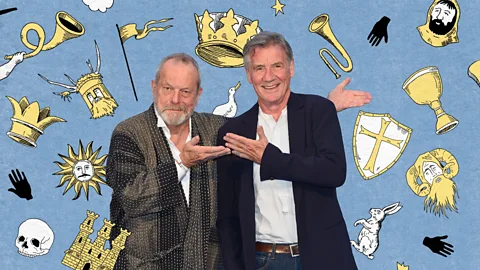 Emmanuel Lafont/ Getty Images
Emmanuel Lafont/ Getty ImagesFifty years after Monty Python and the Holy Grail redefined comedy, stars Michael Palin and Terry Gilliam look back on the freedoms – and limitations – that shaped the film.
An independent British comedy made on a shoestring by a television sketch troupe? It sounds like a film destined to be forgotten within weeks of leaving cinemas – assuming it reaches cinemas in the first place. But Monty Python and the Holy Grail is still revered as one of the greatest ever big-screen comedies, 50 years on from its release in April 1975. Terry Gilliam, who co-directed the film with Terry Jones, thinks he knows why. "Every time I watch it I'm completely bowled over by how incredibly wonderful it is," Gilliam tells the BBC. "It's still so funny, and I just love everything about it."
The Monty Python team first appeared on TV together in a BBC series, Monty Python's Flying Circus, in 1969. Five of the six members – Terry Jones, Graham Chapman, John Cleese, Eric Idle and Michael Palin – had honed their craft in student comedy societies at the Universities of Oxford and Cambridge. The sixth, Gilliam, had moved to the UK from the US, and provided animated segments which linked their surreal sketches. In 1971, some of these sketches were reshot and compiled into a film, And Now for Something Completely Different, but the Pythons had ambitions to make a bona fide feature film – or some of them did, at least.
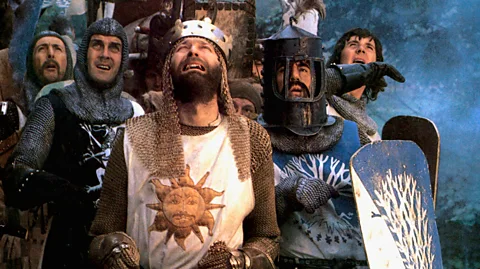 Alamy
Alamy"It was by no means unanimous that we should do a film after the television series," says Palin. "John, to his credit, was doing Fawlty Towers, Eric was doing Rutland Weekend Television, but the two Terrys wanted to direct a film, and I loved cinema as well, so that was the only way forward – not to make it three Python shows tacked one after the other, but to make it a full cinematic experience. No other television series had, as far as I know, leapt into cinema, but we thought we'd have a go."
Chapman and Jones have both died (or ceased to be, to borrow a line from one of their most beloved sketches), and Cleese and Idle were unavailable to talk to the BBC, but Gilliam and Palin reminisce cheerfully about Holy Grail – Palin quietly affable, Gilliam cackling with enthusiasm.
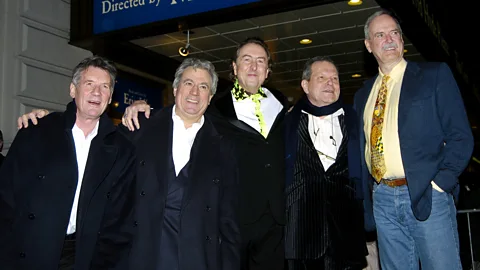 Getty Images
Getty ImagesPalin mentions that he and Jones had made a pre-Python series of historical sketches, The Complete and Utter History of Britain, and Jones would go on to be an acclaimed medieval historian. However, that wasn't why the team chose to build their first proper feature film around King Arthur and the Knights of the Round Table.
"We had to do something that used all six of us," says Palin, "and of course the Round Table was the perfect template for that because we could each play one of the knights. And also because the Holy Grail legend was something that everyone had heard of, but nobody really knew anything about it. You could create any sort of story based around the search for a Grail."
Michael Palin's Five Culture Shifters
The Goon Show (1951 to 1960)
The Goon Shows had a profound effect on me, and I know they did on John Cleese and Terry Jones. For me, they represented a moving-on from my parents' preferences for television and radio. It was just the profusion of ideas – half an hour full of strange images, weird noises, amazing sound.
Heartbreak Hotel by Elvis Presley (1956)
That was a culture shifter for me, because unlike most of the pop songs I was listening to at that time, it made me think that this was something for my generation, and not the generation before.
Lady Chatterley's Lover by DH Lawrence (1928, published in 1960)
These are rather personal choices reflecting on my relationship with my parents. When they got a copy of Lady Chatterley's Lover, it made me feel better towards them. It was a great breakthrough for me to know that they were as interested in sex as I was!
The Rocky Horror Show by Richard O'Brien (1973)
John Cleese invited me along to see the live show in a small theatre in the King's Road. I was quite gobsmacked by this funny and outrageous celebration of the gay world – and there wasn't much of it around at that time. I remember thinking, wow, I've grown up a bit, having seen this.
The London Olympics opening ceremony by Danny Boyle (2012)
It wasn't saying "good old Britain" or "imperial Britain" or anything like that. It was about our way of life in Britain today – and done in such a creative, inventive way. To have a whole sequence about the National Health Service, instead of fireworks and pompous costumes and flags and endless marching – here was something celebratory in a way I'd never expected.
Not that Monty Python and the Holy Grail was ever going to be a straightforward Arthurian adventure. Just as mind-bogglingly absurdist as the sketches that made the group's name, the film boasted faux-Swedish subtitles, Gilliam's instantly recognisable animation, a Trojan Rabbit, the Knights Who Say "Ni!", a debate about whether swallows are strong enough to carry coconuts and a modern-day historian who pops up to comment on the action before being brutally slain by a passing knight. It was, in other words, a unique proposition, which could be why the BBC chose not to invest in it. With the help of theatrical impresario Michael White, the Pythons ended up securing funds from some unusual sources, including Led Zeppelin, Pink Floyd and various record companies.
Palin: "I say to people, 'Led Zeppelin gave us £50,000 – and look where they are now.'"
Gilliam: "Thank God for rock'n'roll is all I can say."
The upside to this unconventional set of backers, Gilliam adds, was that the team had complete creative freedom. "Looking back, it always seemed to me very pure, what we were doing. We were just trying to make ourselves laugh, at the same time as saying interesting things, serious things. There were no outside forces. We, the six of us, made the decisions, end of conversation, and that's a rare thing. Musicians get away with that all the time. Not many film-makers do."
The downside was that even with the Pythons' celebrity fans chipping in "a little bit of money", in Palin's words, the film's budget was less than £300,000 ($393,000). This wasn't much for a sweeping fantasy set in medieval Britain, so the team had to be inventive.
They couldn't afford to have knights riding on horseback, for instance, so King Arthur (Chapman) and his men trot along on foot, with servants behind them tapping halved coconut shells together to make the clip-clop noise of horses' hooves. Another bit of crafty problem-solving came when the team's permission to shoot at several Scottish castles was rescinded at the last minute. Instead, they simply shot Doune Castle near Stirling, Scotland from numerous different angles so that it appeared to be a different castle each time.
"What I love is that Doune Castle has reaped the benefit," says Palin. "It's now the centre of a sort of Python tourist industry, and it's the only castle gift shop to sell ready-cut coconut shells."
Despite its limited budget, one key reason why the film has lasted is that it looks like an authentic period epic, complete with atmospheric footage shot on location in Scotland. "We were frustrated by the television shows because they had rather bad sets and bad lighting and bad everything," says Gilliam of himself and Jones, "and both of us were big fans of Bruegel as a painter and Pasolini as a film-maker. We wanted all of those textures, all of that reality. I think that's what is totally unique about the film: some of the film-makers were serious historians and real film directors."
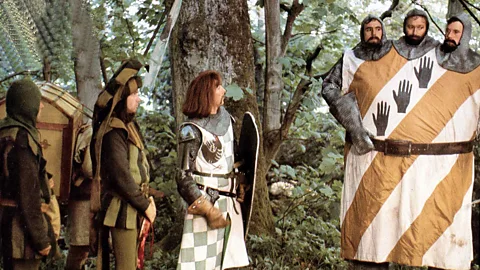 Alamy
AlamyNot all of the Pythons saw the necessity of those Bruegel-and-Pasolini-like textures, though. "One of the joys of the film was looking for locations, places that had history, and trying to make them beautiful," says Gilliam. "But there were days when I got in fights with the rest of the team, who had no interest in creating the times and making it real."
Some members of the group were "constantly moaning" about shooting outdoors, especially when the Scottish rain waterlogged their heavy woollen tunics, Gilliam says. "Mike was fine, Terry was fine, but the others just hated wearing uncomfortable costumes. They just wanted to be funny. But I said, 'You're missing the point. To be funny you've got to be real first. All this has got to be genuine.' I just thought the humour would be much, much funnier if we could ground it in reality."
Ultimately, the two Terrys got their way, and, as Gilliam and Palin agree, Chapman's commitment to the reality of a proud but peeved King Arthur contrasted perfectly with the silliness around him. "Everything about him was totally believable," says Gilliam.
The only trouble with this naturalistic approach to the Middle Ages was that it came to be associated in viewers’ minds with Monty Python, Gilliam says. That meant that any other films with a similar aesthetic – mud, smoke, grey weather, crumbling castles – could seem Pythonesque, however earnest they were attempting to be. Robert Bresson's Lancelot du Lac was released in the UK in August 1975, remembers Gilliam. "It was deadly serious. And people started laughing because it was such a serious attempt to do the real thing, and it wasn't as good as what we were doing."
Holy Grail had profound effects on the Pythons themselves, too. The success of the film convinced Gilliam that he wasn't just an animator, but a director, "because the credits said that", and it boosted the team's international profile, "expanding our control over humanity".
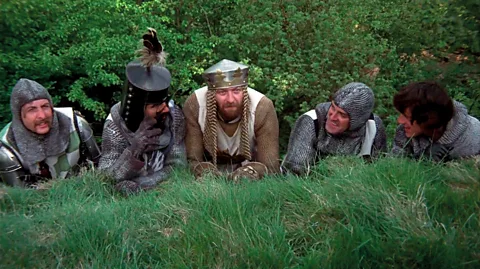 Alamy
AlamyIt also prompted Monty Python to make a follow-up. "There was a feeling even after we'd done The Holy Grail of 'OK, we've done this film, bit of an experiment, but even if it works, we've all got other things to do,'" says Palin. "But as we did the publicity around the world, we spent a lot of time in airports, and the idea that became The Life of Brian was born in one of these bored discussions while waiting for a flight to Dublin or somewhere. Eric came up with the title, Jesus Christ: Lust for Glory, and that steered us towards the Bible story, and it meant that we were all prepared to give time to writing another film – and that was very much on the borderline. It might just have been one film, and that was that."
Terry Gilliam's Five Culture Shifters
Rosa Parks' protest (1955)
What a lady. What's so interesting is that the right person in the right place does something, and suddenly normal people who don't normally pay attention to things say, "Why is this woman not able to sit on the bus like a human being?" These powerful images hopefully wake people up.
Heartbreak Hotel by Elvis Presley (1956) and I Want to Hold Your Hand by The Beatles (1963)
The first time I heard I Want to Hold Your Hand was a huge shift. I was sitting in my car in a parking lot in university, and the sound just got to me. Before that it was Elvis, Heartbreak Hotel. In both cases, I was on my own, I turned on my radio, and the world changed. This was something new and special.
The Pill (1960)
I was around when the pill popped up – and suddenly sex was rampant, ladies and gentlemen! But it was also wonderful how, as sex increased, love seemed to increase, too, and so we had the Summer of Love.
Contemporary politics (2025)
I think we're now going through the biggest cultural shift I've experienced in my whole life. It has gotten very weird to see how quickly all these extreme right-wingers are blossoming.
Not only did Holy Grail lead to two further films, Monty Python's Life of Brian (1979) and Monty Python's The Meaning of Life (1983), it was adapted by Idle and John Du Prez into a long-running Broadway show, Spamalot, which won the Tony award for best musical in 2003. Both Palin and Gilliam sing the show's praises, Gilliam's one reservation being that "it wasn't muddy enough".
Even more remarkably, many of the film's phrases have entered the British lexicon, and some of its characters have become archetypes: failing politicians are regularly compared to the Black Knight, who is determined to keep fighting even when his limbs have been lopped off, while Sir Robin the Not-Quite-So-Brave-as-Sir-Lancelot is brought up when someone is seen to be especially cowardly.
These characters are so resonant, Gilliam suggests, because even at its most ludicrous, Monty Python's humour is "about real people with real attitudes", adding: "and Britain is becoming more and more like the characters in The Holy Grail!"
More like this:
• How Clueless revolutionised the high school comedy
The characters who are cited to Palin most often, he says, are the Knights Who Say "Ni!". "Apparently Elvis Presley liked watching Monty Python and the Holy Grail near to the end of his life. I don't know if he was taking it in, but just the idea of Elvis Presley saying 'Ni' gives me happiness during dark times."
The film has, arguably, offered happiness to many others who watched it during dark times, too. The Pythons weren't on a quest for the secret of immortal comedy, but somehow they stumbled on that Grail. "I just think Python was the perfect chemical balance, the six of us," says Gilliam. "We're all very different, and to put those six people in the same room, and they all basically agree on what they're doing, it's an extraordinary thing. Without any one of us, it was not the same. When Graham died [in 1989], it was already changing. And with Terry [Jones] gone [in 2020]… people say, 'Wouldn't it be great for Python to get together again?' It would be pointless to get together again! It wouldn't work. It was a magical chemical balance. It was spectacular."
Culture Shifters is an interview series in which high-profile creatives reflect on a work of theirs which made a big impact on the world. Read more articles from the series here.
--
If you liked this story, sign up for The Essential List newsletter – a handpicked selection of features, videos and can't-miss news, delivered to your inbox twice a week.
